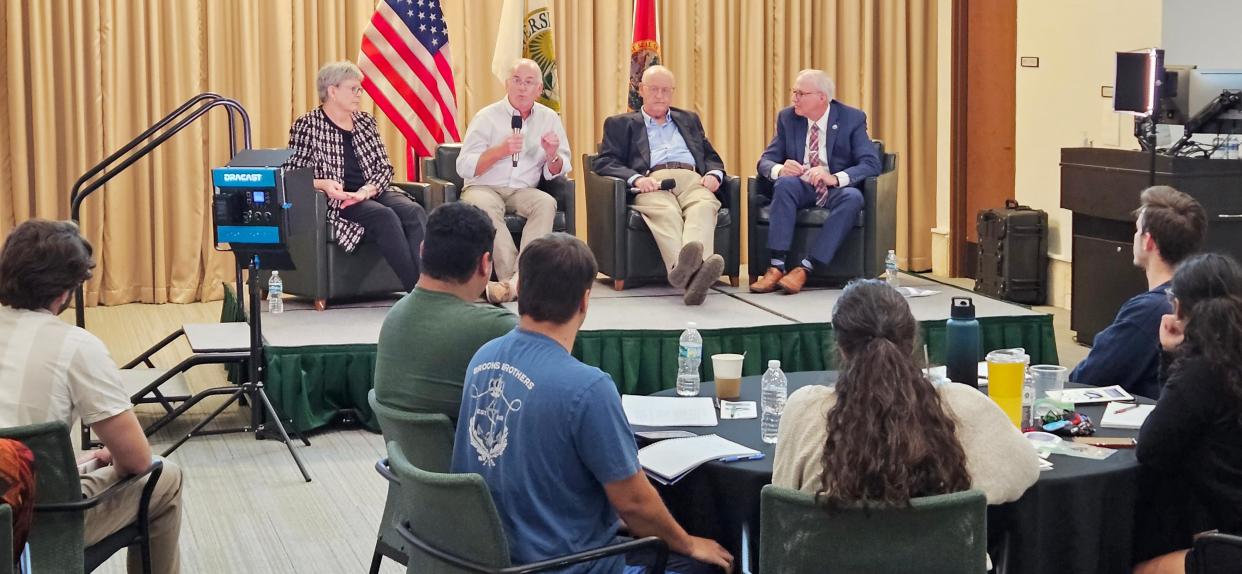Sarasota, Manatee experts highlight efforts to curb red tide by bolstering water quality

Efforts to bolster the health of Sarasota Bay and the Gulf of Mexico against the effects of red tide came to the forefront on Monday at a forum comprised of local experts hosted by the University of South Florida Sarasota-Manatee campus.
Red tide blooms have had a significant impact on Southwest Florida's Gulf Coast nearly every year since 2007, according to information presented by the Sarasota Bay Estuary Program. One of the most significant blooms in the region came between late 2017 and early 2019, wreaking havoc on the local economy.
The area has also experienced red tide blooms since then, including one after Hurricane Elsa some experts fear was worsened by pollution in 2021 from the wastewater breach at the former Piney Point fertilizer plant in north Manatee County, although the brunt of the impact was felt in Tampa Bay near St. Petersburg. The area also had red tide following Hurricane Ian.
From the archive: Slow summer tourism in Sarasota could be a "red tide hangover"
More: Red tide and COVID-19 variants create tourism uncertainty in Sarasota-Manatee
The Sarasota Bay Estuary Program has undertaken a study that shows that the length of red tide blooms during many of those years share a correlation with the amount of nutrients known to have flowed into the gulf during the month preceding and the first month during the red tide event, Director Dave Tomasko said.
"Overall, humans have made red tide last longer, would be our conclusion, and if we could fully implement the nutrient load reduction that is called for by the state of Florida we could knock it back by maybe a month," he said.
Sandy Gilbert, chairman and CEO of Solutions to Avoid Red Tide, highlighted local efforts that help address red tide, such as initiatives to seed clams and oysters to help filter local waters and enhance retention ponds to prevent nutrients that feed red tide from flowing into the environment from them, and wastewater treatment plant improvements planned in Sarasota County.
Charlie Hunsicker, Director of the Manatee County Department of Natural Resources, said the county also participates as part of the bivalve seeding effort.
"It's using nature to help solve a continuous problem," Hunsicker said. "Clams and oysters work every day, all night long, they don't require overtime or have to go home and do homework. They're still there every day to clean water."
He also highlighted a Manatee County fertilizer ordinance created in 2010. The ordinance prohibits the use of fertilizer during a restriction season, which runs from June 1 through Sept. 30. However agricultural properties, properties used for grazing livestock, golf courses, athletic fields and vegetable gardens.
The county is also working to purchase about 98 acres of land near Emerson Point for conservation and is considering the purchase of other environmentally valuable lands for protection.
"We focus, and have focused in Manatee County, our acquisition strategy along the coastlines," Hunsicker said. "Properties that are literally on the edge of the water, and we've been successful. Emerson Point is on the north side of the Manatee River... There's a 98-acre piece there that's vacant, and we're going to go after that. Ninety-eight acres directly by Emerson Point that would support 96 new homes. For 20 years, we've had that in mind."
Gilbert said he'd like to see local governments continue their efforts, and emphasized that there are steps the public can take to help address red tide.
"I've never liked the phrase, although it's true, that it's a naturally occurring phenomenon," Gilbert said. "Because what people hear when you say that is that they can't do anything about it. Nitrogen in fertilizer and nutrient (reduction) is something we can do. It isn't the only cause of red tide, but it is a major part of it and we can do something about it."
This article originally appeared on Sarasota Herald-Tribune: Forum highlights efforts curb red tide in Sarasota and Manatee

